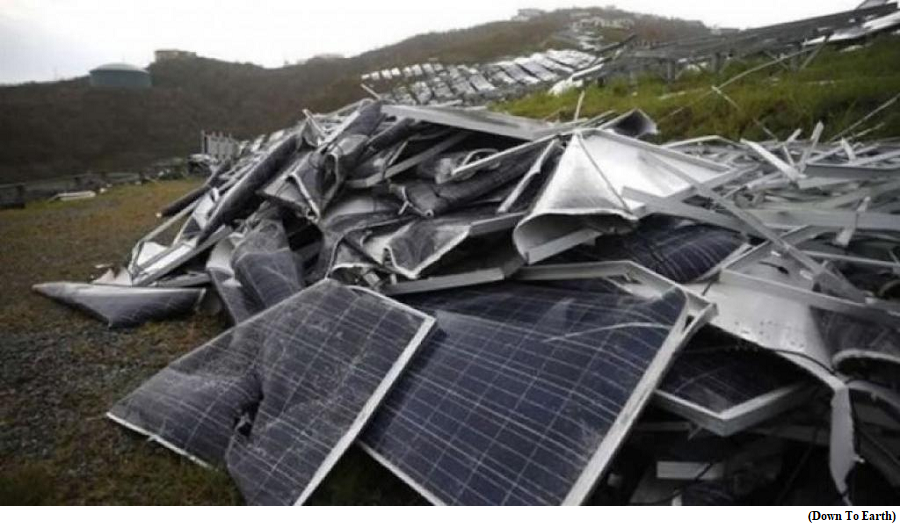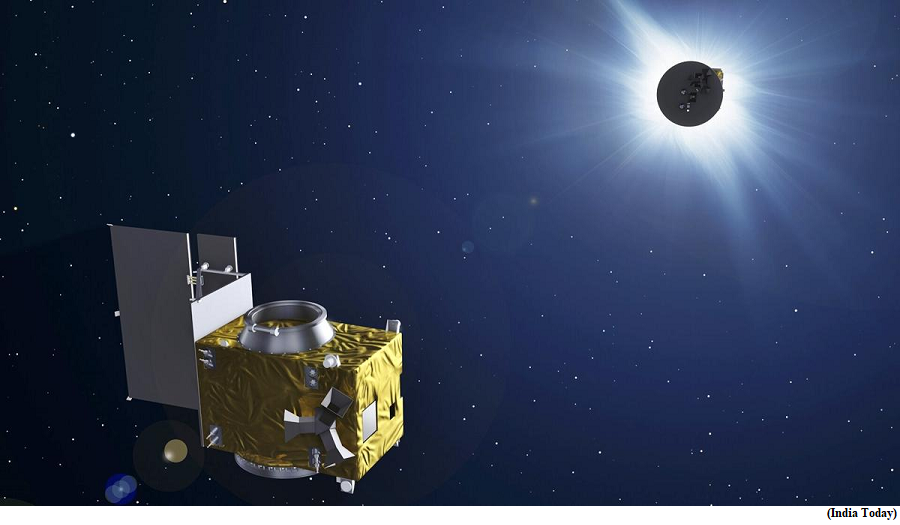How to manage India’s solar PV waste problem? (GS Paper 3, Science and Tech)

Context:
- There has in the last few years been a concerted push from policymakers in India to transition to a circular economy and to, among other things, enable effective waste management.
- But waste management in the solar photovoltaic (PV) sector still lacks clear directives.
What is PV waste?
- Globally, India has the world’s fourth highest solar PV deployment. The installed solar capacity was nearly 62GW in November 2022. This augurs a colossal amount of solar PV waste.
- According to a 2016 report by the International Renewable Energy Agency, India could generate 50,000-3,25,000 tonnes of PV waste by 2030 and more than four million tonnes by 2050.
- India’s solar PV installations are dominated by crystalline silicon (c-Si) technology. A typical PV panel is made of c-Si modules (93%) and cadmium telluride thin-film modules (7%).
- A c-Si module mainly consists of a glass sheet, an aluminium frame, an encapsulant, a backsheet, copper wires, and silicon wafers. Silver, tin, and lead are used to make c-Si modules. The thin-film module is made of glass, encapsulant, and compound semiconductors.
Is this waste recovered or recycled?
- As these panels near expiration, some portions of the frame are extracted and sold as scrap; junctions and cables are recycled according to e-waste guidelines; the glass laminate is partly recycled; and the rest is disposed of as general waste.
- Silicon and silver can be extracted by burning the module in cement furnaces.
- According to a 2021 report, approximately 50% of the total materials can be recovered.
- India’s challenge is the growing informal handling of PV waste. Only about 20% of the waste is recovered in general; the rest is treated informally.
- As a result, the waste often accumulates at landfills, which pollute the surroundings. Incinerating the encapsulant also releases sulphur dioxide, hydrogen fluoride, and hydrogen cyanide into the atmosphere.
What are the gaps?
- First, simply clubbing PV waste with other e-waste could lead to confusion. Instead, India should formulate and implement provisions specific to PV waste treatment within the ambit of the e-waste guidelines. And a Central insurance or a regulatory body should be set up to protect against financial losses incurred in waste collection and treatment.
- Second, the waste generated from PV modules and their components is classified as ‘hazardous waste’ in India. To further drive home this label, pan-India sensitisation drives and awareness programmes on PV waste management will be beneficial.
- Third, considering that India’s local solar PV-panel manufacturing is limited, there is need to pay more attention to domestic R&D efforts. Depending on a single module type will dis-uniformly deplete certain natural resources and stunt the local capacity for recycling and recovery of critical materials.
- The domestic development of PV waste recycling technologies must be promoted through appropriate infrastructure facilities and adequate funding.
Why should India act now?
- Considering the rate at which these panels are being installed around the country, India is expected to generate an enormous amount of waste over the next 20 years.
- In fact, India is expected to become one of the top five leading photovoltaic waste producers worldwide by 2050.
- Now is the right time for it to install clear policy directives, well-established recycling strategies, and greater collaboration, so that it doesn’t find itself caught unprepared against a new problem in the future.
India ranks fifth in national contribution to warming: Study
(GS Paper 3, Environment)
Why in news?
- India is responsible for 0.08 degrees Celsius of warming from the 1850s through 2021, a new study estimated.
- Overall, the country ranks fifth among the top 10 contributors to warming.

Details:
- Researchers from Europe and the United States calculated national contributions to warming due to greenhouse gases such as CO2, CH4 and N2O since the 1850s.
- By focussing on the three gases that most countries include in their Nationally Determined Contributions, this dataset is uniquely positioned to informing climate policy and benchmarking.
- India’s emissions of carbon dioxide (CO2), methane (CH4) and nitrous oxide (N2O) from 1851-2021 have resulted in 0.04°C, 0.03°C and 0.006°C of global warming over pre-industrial levels.
Key Findings:
- Their analysis showed that CO2 is responsible for 1.11°C of warming compared to methane’s 0.41°C and nitrous oxides 0.08°C.
- Further, the United States topped the list of countries, with a contribution of 0.28°C (17.3 per cent) of rise in temperature.
- China stood second with 0.20°C (12.3 per cent) of warming, followed by Russia’s 0.10°C (6.1 per cent), Brazil’s 0.08°C (4.9 per cent) and India’s 0.08°C (4.8 per cent).
- Indonesia, Germany, the United Kingdom, Japan and Canada each contributed 0.03-0.05°C of warming.
- National contributions to change in global mean surface temperature from historical emissions during three time periods.
- Since 2005, India climbed to the fifth spot from the 10th. China, too, rose to the second position after overtaking Russia.
LULLUCF Factor:
- The land-use and forestry sector is a significant contributor in half the countries.
- CO2 emissions from land use, land-use change and forestry (LULUCF) in Brazil led to 0.04°C of warming.
- LULUCF emissions also dominate Indonesia’s contributions to warming through historical CO2 emissions, the study read.
- In contrast, LULUCF emissions during 1851-2021 were negative in several European countries.
- Also, the LULUCF sector accounted for 38 per cent of the total warming from CH4 emissions and 72 per cent from N2O emissions between 1851-2021.
- The contribution of India, China and Brazil towards warming due to CH4 and N2O increased by 110 per cent, 56 per cent and 55 per cent, respectively, compared to CO2-related warming alone.
- The researchers, however, highlighted that CH4 and N2O emissions are more uncertain than that of fossil CO2.
Way Forward:
- Tracking national contributions to climate change can help understand the burden of responsibility carried by each country.
- It can also further inform the design of international policies that pursue equitable decarbonisation pathways.
India's PSLV to launch Europe's Proba-3
(GS Paper 3, Science and Tech)
Why in news?
- The two-spacecraft forming the European Space Agency’s Proba-3 mission are ready with instruments and sensors allowing them to maneuver to a millimeter-scale precision relative to one another.
- The spacecraft will fly into space on India's Polar Satellite Launch Vehicle (PSLV) in 2024.

Details:
- The spacecraft is set to go into the testing phase where engineers will subject them to a simulated space environment.
- The spacecraft has been designed to demonstrate precision formation flying in space, where they will fly together maintaining a fixed configuration as a large rigid structure.
What will Proba-3 do in Space?
- The Sun is a million times brighter than its surrounding corona, so eclipsing it is essential for coronal studies. This is what happens during a solar eclipse of the Sun by Earth's Moon. But that sporadic event lasts for only a few minutes.
- As a world first, Proba-3's two satellites; the Coronagraph spacecraft and the Occulter spacecraft will maintain formation to a few millimeters and arc second precision.
- The two probes will together form a 144-m long solar coronagraph to study the Sun’s faint corona closer to the solar rim than has ever before been achieved.
- This will open up continuous views of the Sun’s faint corona, or surrounding atmosphere, for scientific observation.
PSLV:
- Known as the workhorse of the Indian Space Research Organisation, PSLV is the third-generation launch vehicle capable of placing multiple payloads into orbit in a single mission.
- The four-stage rocket has been used to launch various satellites into Geosynchronous and Geostationary orbits.
- The 340-kilogram spacecraft will be deployed by PSLV in a high Earth orbit with an orbital period of 19.7 hours. They will be placed in a highly elliptical orbit of 600 x 60530 km.
What’s next?
- The spacecraft will now be shipped to IABG in Germany for the start of a four-month environmental test campaign, simulating every aspect of the launch and space environments.




